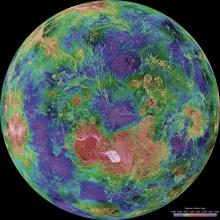You are here
Venus

The Venusian clouds kept astronomers from seeing the planet's surface. Without visible landmarks, they could not measure how fast Venus turns on its axis. It took cloud-penetrating radar, first aimed at Venus in the early 1960s, for scientists to discover that Venus rotates backward as compared to the other planets in the solar system. This means that the Sun rises in the west and sets in the east. And Venus' rotation is extremely slow, so a "day" on Venus is longer than a year.
Early spacecraft discovered that Venus' atmosphere is thick and toxic. It is made primarily of carbon dioxide, with a surface pressure 90 times greater than on Earth -- equivalent to the pressure at a depth of more than a half-mile (900 meters) below the surface of Earth's oceans. Clouds of sulfuric acid, blown by high-speed winds, top the atmosphere.
This dense atmosphere makes Venus the hottest planet in the solar system. The atmosphere absorbs the Sun's heat but doesn't allow it to escape. This "greenhouse effect" has heated Venus' surface to about 860 degrees Fahrenheit (450°C) — hot enough to melt lead.
The first views of the surface came from four Soviet landers, each of which survived for only a few minutes before succumbing to the heat and pressure. The images showed flat, angular rocks around the landers, but not much else.
The best view of Venus came from the Magellan spacecraft, which entered orbit around Venus in 1990. Its cloud-penetrating radar mapped 98 percent of the planet's surface. Magellan discovered mountains on Venus that are taller than any on Earth, as well as a valley that is the longest and deepest in the solar system. Thousands of volcanoes dot the Venusian surface. Magellan provided hints that some of them may still be active, and later orbiters discovered additional evidence of active eruptions. Magellan's observations suggest that the planet's entire surface has been repaved by massive volcanic eruptions, although the timing is uncertain. Some planetary scientists suggest it happened quickly, in just tens of millions of years. More recently, though, others have suggested the repaving could have played out over hundreds of millions of years or longer.
Almost all of the impact craters detected on Venus are large. The surface lacks smaller craters because small meteoroids burn up in the planet's thick atmosphere before they hit the ground.
Recent studies have suggested that those clouds could provide the right conditions for microscopic life: the proper temperatures, the right mix of chemical elements, and sources of energy in the Sun and lightning. Some have even proposed that dark features seen in some ultraviolet images of the cloud could be mats of microbes. Several scientists have proposed that future Venus missions probe the clouds to settle the issue.
Although Venus is completely dry today, a spacecraft in the 1980s found evidence that the planet could have been much wetter in the distant past. In fact, it might have had enough water to cover the entire planet to a depth of 50 feet or more.
Scientists think Venus' interior is a lot like Earth's, with an iron-nickel core surrounded by a rocky mantle. But unlike Earth, Venus does not have tectonic plates (although it's possible it had them in the past), and it rotates so slowly that it doesn't generate a magnetic field.
June 2, 2021
Viewing Guide
♀The brilliant planet starts 2023 as the Evening Star, and continues through August. Then it vanishes from view as it crosses between Earth and Sun. It will return, as the Morning Star, by late August, and will stay in the morning sky until December.
Exploration
The Soviet Venera 9 became the first spacecraft to transmit pictures from the surface of another planet when it touched down on Venus in 1975. And in a mission that began 15 years later, the American Magellan orbiter used cloud-penetrating radar to map more than 98 percent of Venus' surface. Its images revealed hundreds of volcanoes, giant lava flows, cracked domes of volcanic rock, and long canyons. Europe's Venus Express made extensive measurements of the planet's atmosphere, discovering that lightning crackles in some of the clouds and finding evidence of active volcanic eruptions.
Keywords
At a Glance
| Discovery |
| Known since antiquity |
| Name |
| Roman goddess of love |
| Average Distance from Sun |
| 67,237,910 miles 108,208,930 km 0.723 Astronomical Unit |
| Mass |
| 0.815 times Earth's mass |
| Equatorial Diameter |
| 7,521 miles 12,104 km |
| Length of Day |
| 243 Earth days (retrograde) |
| Length of Year |
| 0.62 Earth years 224.7 Earth days |
| Surface Gravity |
| 0.91 that of Earth (If you weigh 100 pounds, you would weigh about 91 pounds on Venus.) |
| Known Moons |
| None |
Teacher Copies
Request a free copy of The Solar System or Beyond the Solar System for your classroom. Bulk copies are available for $1.50 each in quantities of 30 or more. Shipping is included. Call 512-471-5285 for orders of 30 or more.
 The Astro Guides for the Solar System and Beyond the Solar System are supported by the National Aeronautics and Space Administration under Grant Nos. NNG04G131G and NAG5-13147, respectively.
The Astro Guides for the Solar System and Beyond the Solar System are supported by the National Aeronautics and Space Administration under Grant Nos. NNG04G131G and NAG5-13147, respectively.


